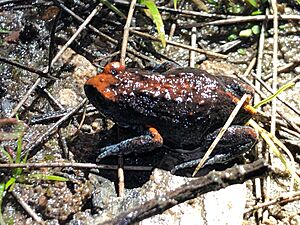Magnificent brood frog facts for kids
Quick facts for kids Magnificent brood frog |
|
|---|---|
 |
|
| Conservation status | |
| Scientific classification |
The magnificent brood frog (Pseudophryne covacevichae) is a special kind of frog. It belongs to the Myobatrachidae family, which are often called Australian ground frogs. This frog lives only in Queensland, Australia. You can find it near Ravenshoe and in the Paluma Range National Park. Its scientific name, covacevichae, is a tribute to Jeanette Covacevich. She was an Australian scientist who studied reptiles and amphibians.
Contents
What Does It Look Like?
The magnificent brood frog is quite small. It measures about 24 to 28 millimeters (about 1 inch) long. Its back can be a bright reddish-brown or yellow. It has faint black lines along its back.
Around its bottom (called the cloaca), there is a big yellow patch. This patch continues up its back as a thin yellow line. The sides of its body are black. Sometimes, these black areas have hints of white or gray. The top part of its upper arms is bright yellow. Its belly has a cool pattern of black and white, like marble. If you look closely at an adult frog, the top half of its eye (the iris) is yellow or gold.
Where Do They Live?
Magnificent brood frogs live in open eucalyptus forests. They prefer areas where water seeps out of the ground. You can find them at high places, usually above 800 meters (about 2,600 feet).
Life Cycle and Habits
Male frogs call out to attract females. They usually call from wet areas at the bottom of grass clumps. This happens on wet summer and autumn nights. Sometimes, they even call during cloudy days.
The female frog lays her eggs on moist soil. She places them in or very close to these wet seepage areas. The male frog often stays to guard the eggs. When the eggs hatch, the tiny tadpoles start to move. They either crawl down the wet ground or get washed into small streams. They finish growing into frogs in small pools of water.
Protecting the Magnificent Brood Frog
This frog species faces some dangers. Its home is being lost or damaged. This can happen because of things like animals grazing, logging trees, building roads, or clearing land for development.
Scientists used to think this frog lived in only a few places. But finding them in the Paluma Range means they might be more widespread than we thought. Protecting their wet forest homes is very important to help these magnificent frogs survive.


